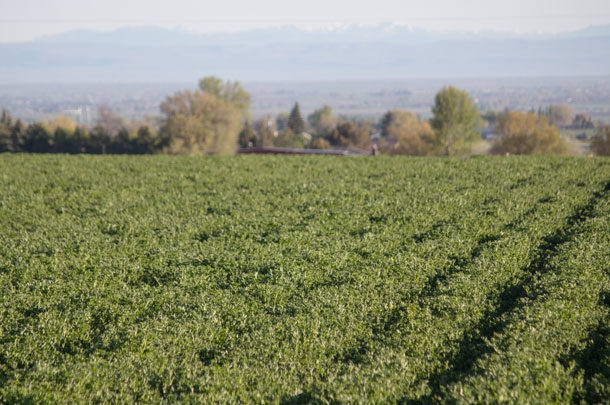Cut it
Rewards
Fall alfalfa often produces the best quality forage of the year. Leafy plants with fine stems grown with reduced temperature stress can result in award-winning, high-value dairy hay or haylage.
The resulting forage provides immediate value, compared with the delayed returns the following year by leaving it.
Minimizing the amount of alfalfa stubble entering winter has been shown to often reduce injury from alfalfa weevils the following spring.
Risks
Alfalfa dries very slowly during the cooler temperatures and shorter day lengths of fall, increasing the risk of weather damage. It can be tempting to bale before hay is adequately dry enough for safe storage, requiring use of costly preservatives or risking storage losses.
Heat damage, mold or spontaneous combustion fires can occur when rich, fine-stemmed, high-quality hay is packaged into tight, heavy bales, especially if it is baled just a little too damp. Plentiful nutrients in a tight, dense package that is a little too wet is an ideal environment for heat-producing microbes.
High-quality alfalfa that experiences weather or heat damage or mold can quickly turn into low- to moderate-quality forage, reducing or eliminating the potential economic benefit from taking the late season cutting.
Competition for labor from harvest of annual grain crops or silage can be high.
Winterkill or injury may increase if the winter-hardening process is disrupted by harvest. Alfalfa plants are more likely to survive winter when, following final harvest, they either have sufficient regrowth to accumulate adequate nutrient reserves or they experience little depletion of an already adequate accumulation of nutrient reserves.
Graze it
Rewards
Alfalfa can provide considerable, high-quality grazing during fall, avoiding problems of slow curing and the cost of baling.
It can extend the grazing season in areas where pasture typically becomes limited in the fall.
It can be used as a protein supplement when grazed, along with low-quality forages such as crop residues or dormant pasture.
Risks
Bloat risk must always be understood and managed. Fully bloomed alfalfa is of low risk, but young, vegetative growth can be very dangerous. After a hard freeze, bloat risk increases for several days until plants begin to wilt, after which bloat risk declines considerably.
Fences and water may need to be added to grazed areas.
Stands can be damaged if fields aren’t dry and firm when grazed. Sacrifice areas or penned feeding areas may be needed to minimize damage to alfalfa crowns.
Large cow pies that degrade slowly can plug sickle bar mowers at first harvest next spring.
Leave it
Rewards
If alfalfa is not cut or grazed, winter hardiness should be maximized with vigorous early growth next spring. Taller stubble will hold snow for extra moisture and insulation, as well as provide more reliable erosion control. Root heaving should be minimized. Ice damage may be reduced.
Cost of harvesting the relatively low, late-season yield is eliminated.
Various wildlife species may use remaining growth for shelter or as a feedstuff. (This may be considered a risk in some instances.)
Risks
Use it or lose it – the value of next year’s forage is less certain than that of the current year. FG
Bruce Anderson is an extension forage specialist with the University of Nebraska – Lincoln. Email Bruce Anderson.
PHOTO: To graze or not to graze? To cut or not to cut? Late-season alfalfa management often makes the best quality hay of the season, but should we harvest it? Photo by Lynn Jaynes.










